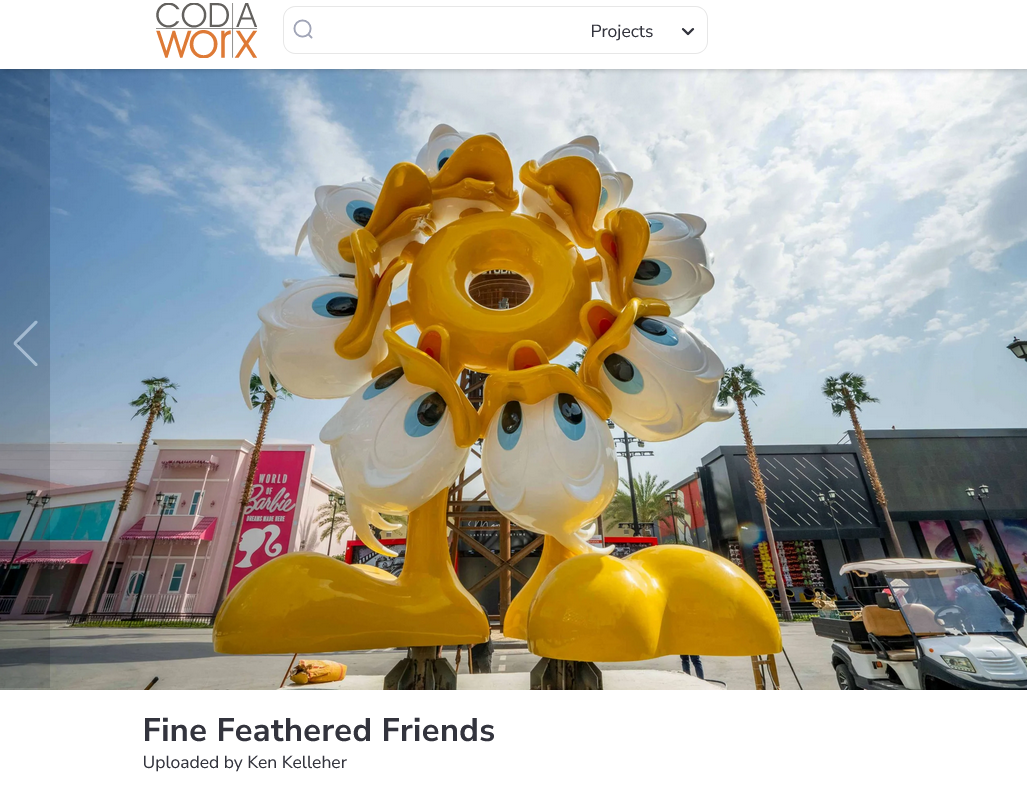September 2024 Archives
Premiere Networks, Rush Limbaugh's syndicator, has added Your Morning Show with Michael DelGiorno to its offerings for national radio syndication. DelGiorno joins Glenn Beck, Clay Travis & Buck Sexton (Limbaugh's handpicked heirs in his timeslot), and Sean Hannity in the Premiere lineup. Congratulations to Michael for reaching this pinnacle. National syndication by Premiere is every conservative talk radio host's dream.
Here in Tulsa, Your Morning Show can be heard from 5 a.m. to 8 a.m. on 1300 the Patriot (KAKC), which also carries Glenn Beck and Clay & Buck. The station is now simulcast on 93.5 (K228BR), a Tulsa translator for 106.1 KTGX-HD2 in Talala. The FM frequency was Chrome FM, playing oldies from 2007 to 2017. Broadcasting with 250 watts from 27th and Memorial, 93.5 covers most of the City of Tulsa east of the Arkansas River and the Cherokee Expressway. With 100,000 watts, 106.1 HD2 reaches from Hominy to Grove, Independence, Kansas, to Haskell.
DelGiorno launched Tulsa talk radio station KFAQ 1170 in 2002, but left in 2007 for a mid-morning slot at WWTN Nashville, which he held for 15 years. He launched Your Morning Show last October in Nashville, quickly adding iHeart stations in Tulsa and Oklahoma City, then expanding to a total of 25 cities coast-to-coast. (Driving through Maryland earlier this year, I had the surreal experience of listening to DelGiorno on Freedom 104.7, then turning the dial and hearing the voice of the late Pat Campbell, DelGiorno's successor at KFAQ, promoting Purity Products vitamin supplements.)
In the linked story, DelGiorno thanks Brian Gann, among others, for making this happen. Gann was program director and news director at KFAQ when DelGiorno was there; he has been with iHeart since 2014, now serving as a regional news director.
RELATED:
The KAKC entry on Wikipedia has a detailed history of 1300's ownership and format, although the information from the 1990s is rather scant. My 2021 intro article on 1300 The Patriot delves into the station's documented history and my own memories of its previous news/talk incarnations.
Griffin Media converted KFAQ 1170 from news-talk to sports-talk KTSB The Blitz in 2021. In June 2024, Griffin changed the call letters to KOTV-AM and is using the signal to simulcast the audio of News on 6 Now (digital channel 6.3 over the air; channel 53 on Cox Cable). The move ended the daily broadcast career of The Blitz morning show host Rick Couri, although he continues to do sports play-by-play.
Older readers will remember that back in analog TV days you could tune your FM radio to the bottom frequency and pick up the audio of VHF channel 6, which occupied 82-88 MHz, just below the FM radio band. While it's great to have another way to hear Travis Meyer during severe weather, it's otherwise a waste of a heritage 50,000-watt clear-channel signal which once was the Voice of Oklahoma.
This Saturday, September 21, 2024, at noon, I will be a guest on Tulsa Beacon Weekend, hosted by Jeff Brucculeri. The hour-long interview program is heard in Tulsa on KCFO AM 970, live-streamed online here and on the KCFO app. The show is a production of the Tulsa Beacon, the weekly newspaper founded in 2001 by the late Charley Biggs.
My interview is the second half of the program. Jeff and I discussed the recent City of Tulsa election and Oklahoma primary, the mayoral recount and November runoff, and my recent entry about Tulsa municipal boundaries and fence lines.
The most recent episode is available to listen again for one week through the KCFO app and through the website: From the Listen Live popup, choose Menu, then the microphone icon, then choose Tulsa Beacon Weekend; Joe Riddle's Old Time Radio Theater is also available.
UPDATE: Here's a direct link to the audio file, which will be available through Friday, September 27. The first half of the program is an interview with former HGTV host David Benham, co-author with his brother Jason Benham of Miracle in Shreveport.
Happy 918 Day to those who celebrate sequences of three digits arbitrarily chosen by public utilities.
The artist who was awarded a $250,000 commission from the City of Tulsa to build a Route 66 "roadside attraction" has released artwork showing a revision to his controversial proposal.
Back in mid-August, the City of Tulsa announced that the Route 66 Commission had given a $250,000 commission to Ken Kelleher for a 21-foot-tall statue to stand near 13th Street and Lawton Avenue, atop the hill that overlooks Cyrus Avery Plaza and the 11th Street Bridge over the Arkansas River. The news was greeted with outrage, not from uptight low-brow philistines like me, but from Tulsa's young artist community, angered that local talent would be overlooked in favor of an apparently AI-generated rendering that looks highly derivative and on the edge of intellectual property theft.
The prominence is known in the context of the Tulsa Tough bicycle race as Cry Baby Hill, a particularly steep climb from Riverside Drive up Lawton Avenue where cyclists encounter what the official website describes as "an adults-only marriage of Mardi Gras + cycling." Kelleher's winning proposal is called "Cry Baby Cry" and features a silver-skinned figure with a prominent cowlick and tears trailing down from cartoonish eyes. It has been described as "emo Astroboy," "Temu Astroboy," or a slenderized version of the Big Boy restaurant mascot.
In response to complaints that the proposed figure had nothing to do with Route 66, Riverview neighborhood, or a bicycle race, Kelleher today released newly generated images of two revised concepts. In one, the figure is still standing in the same pose but is now also wearing a hat with the word CRYBABY on the bill and a shirt with the logo of Tulsa's Soundpony Lounge, the cycling-themed bar near Cain's Ballroom that invented the Cry Baby Hill tradition. the logo of Anchorball.ai, Kelleher's design website, is on the hat and sneakers. In the other concept, the figure, dressed as above, is seated on a child's bicycle, wearing a hat and a shirt. The Astroboy/Big Boy quiff is concealed by the hat, but the resemblance remains.
In the press release announcing Kelleher's win, Mayor G. T. Bynum IV stated: "This sculpture will be quintessentially Tulsa, and I couldn't be more excited for the enthusiasm that we all have for this stretch of our Mother Road and Cry Baby Hill. I am thrilled to have an artist who is helping bring this idea to life, and I'm eager that Tulsa has yet another way to celebrate the most famous road in American history here in the Capital of Route 66."
This quarter-million dollar commission was the outcome of a Request for Proposals (RFP), one of a set of four for development of the now-bare hill northeast of Southwest Boulevard and Riverside Drive, an area designated since 2005 for a taxpayer-funded Route 66 attraction. This particular RFP was for a "roadside attraction." An advisory committee ranked submissions and Kelleher was selected.
The RFP stated that "this artwork will echo the familiar form of kitsch regional roadside attractions yet focus on contemporary fanfare at Cry Baby Hill.... The installation should be classic, kitschy, and worthy of countless roadside selfies." The RFP also set out "the expectation that any explicit baby representations are not depicted with a particular human skin tone color."
Kitsch -- defined by the Digitales Wörterbuch der deutschen Sprache as "ostensibly stylish, cultured, upper etc., but sweetish-sentimental (and artistically worthless) product of bad taste" -- is a term applied to objects like lawn flamingos, garden gnomes, and the kind of knick-knacks you'd find at a gift shop.
The kitsch that draws visitors from around the world to Route 66 was not created to make an ironic artistic statement. It could be whimsical folk art, e.g., Hugh Davis's Blue Whale, Ed Galloway's World's Largest Totem Pole. More often it was created as an attention-getting device for a roadside business. It might be a series of billboards -- the Fat Man of Club Cafe -- or a giant sign -- Roy's Motel -- or a giant object that serves as a sign -- Twin Arrows -- or the building itself as the sign -- the Wigwam Motel or Hugh Davis's ARK.
Roadside kitsch was not commissioned by a government committee with a big budget. It is an expression of constraints: Getting the attention of passing drivers within the owner's limited funds, his limited artistic skills, and the functional limitations of the materials available to him. Those constraints make roadside attractions a deeply individual expression with an attractively humble charm. Government-funded, committee-approved kitsch is an oxymoron.
The RFP specifically compares the proposed attraction to the repurposed Muffler Man that stands outside Mary Beth Babcock's Buck Atom's Cosmic Curios on Route 66. Why should the City of Tulsa create a competing attraction? If passing Route 66 cruisers have time for only one selfie stop in Tulsa, wouldn't it be better for the economy and for sales tax collections if they stop at Buck Atom's and spend some money on kitschy souvenirs there and across the street at Decopolis?
After the official announcement, the complaints crescendoed. The comments on this KJRH Facebook post are nearly unanimous in their opposition to the selection. Only one member of the committee voted against the award: the representative from Riverview neighborhood.
The City of Tulsa's response to a query from KJRH stated that the focus of the purchasing process "is on things like capability of applicants to deliver on time and within budget, experience with similar projects, and with meeting the desired deliverables."
Which raises the question: Does Ken Kelleher have experience with similar projects? Does he have a demonstrated capability to deliver on time and within budget? Tulsans critical of the pick noticed that Kelleher's website is full of realistic renderings of virtual, unbuilt and unbuildable scupltures. News stories linked on his website, mostly from 2018, all linked on Kelleher's website describe his monumental work as imaginary, not real. For example, a 2018 article from MyModernMet.com (emphasis added):
Artist Ken Kelleher combines his training as a sculptor with his prowess in UX design to create hyperrealistic projections of public sculpture. Kelleher allows his imagination to run free, placing contemporary sculptures everywhere from Venice's busy St. Mark's Square to minimalist interiors. Working with different series, Kelleher churns out three-dimensional renderings that give potential clients a look at the artwork that could decorate any given environment.
(See below for quotes from each of his linked articles.)
I have searched, so far in vain, for independent news stories, photos, and video showing a permanently installed, real-world, outdoor sculpture of similar size and complexity to Kelleher's proposed Tulsa installation. I have found Google Maps images of a set of four 10-ft tall monochrome figures claimed by Kelleher in a park in Krasnodar, Russia, a very recent blog entry with photos of a monochrome 3D squiggle in a new urban development in San Diego, and a video clip showing a large monochrome hat installed in an indoor atrium in a cruise liner. I've been unable so far to find independent confirmation of other installations claimed by Kelleher in Saudi Arabia, Qatar, Indonesia, and China, some of which are said to be in private collections.
UPDATE 2024/09/20: I struck the world "claimed" above because I've found more independent attestation of Kelleher's "Inner Child" installation at Galitsky Park in Krasnodar, Russia. This video of a December 2021 walk through the park during snowfall shows the dedicatory plaque and the four identical figures. The park opened in 2017 and was donated by Russian billionaire retailer Sergey Galitsky.
Tulsans have noticed that many of the images on Kelleher's website flirt with copyright violations. The sculptures he claims to have installed at Boulevard City shopping district in Riyadh, Saudi Arabia, include what looks like Sesame Street's Elmo in a red track suit, called "Elio" and eight Donald Duck heads attached to a donut with feet. The handful of Kelleher's photos of this installation that include people don't show any interaction between passers-by and the sculptures.
The Woofie series, which Kelleher doesn't claim to have realized, reminds me of the endless minor variations in Non-Fungible Token (NFT) series, like Bored Ape. Xs in place of eyes is a cartoon convention for death, making these characters even more disturbing.
Kelleher is also something of a "musician," likely with the help of AI. On July 17, 2024, four days after the first assassination attempt against Donald Trump, Kelleher posted a rap song to his Anchorball - Ken Kelleher Soundcloud account called "Six Inches to the Right." The image with the song shows the Statue of Liberty in chest-deep water, and the description reads, "How 6 inches to the right could have saved democracy." (Hat tip to Angie Brumley for spotting this on Kelleher's Instagram.)
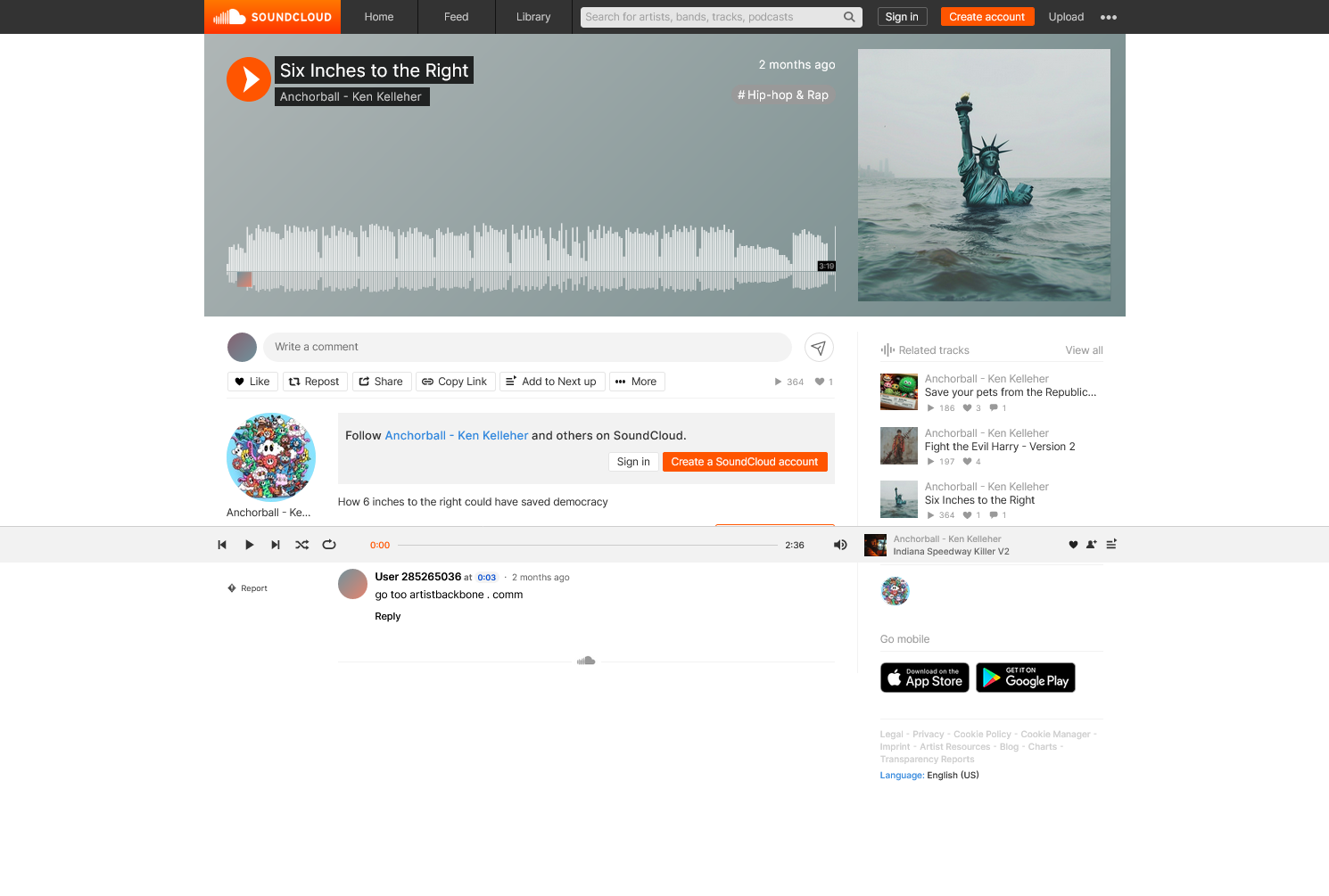
I've long said that most city officials don't "get" Route 66. They know it attracts international visitors, but they don't really understand why, and they expect to be able to exploit that interest through the usual repertoire of government construction contracts. "Streetscaping" is a favorite line item: Concrete pavers and faux-historical acorn lights and park benches. In 2000, there was talk of including money for Route 66 in the "Tulsa Time" sales tax package -- it was designated for "demolition and clearance". One of the task force leaders suggested turning Route 66 into a "tree-lined boulevard." I suggested at the time that funds should go into grants for building restoration, facade improvements, and neon repair, following the example of the federal Route 66 grant program, but that idea was knocked down as impractical and maybe unconstitutional.
Even the committee assembled to spend the Vision 2025 money didn't seem to get it. Their report said to "Make it hip -- in the era of iPods and blogs, Route 66 desperately needs a cool factor." I wrote at the time that they didn't "understand the idea of a niche attraction. Route 66 is never likely to be a mass appeal attraction. The way to approach it is to make it a high-quality, must-see attraction for enthusiasts, but make it accessible to interested outsiders. If you take the other approach -- dumb it down for people who don't know and don't care about 66 -- you won't create anything interesting enough to make it worth the enthusiasts' while to stay the night and spend money."
The way you make your part of Route 66 must-see is through preservation and small business, something too many local politicians have failed to appreciate. The government laid the concrete, but it's what's on the side of the road, quirky only-in-America landmarks and businesses, built by quirky individuals, that visitors hope to encounter -- not big government projects (the Communists built plenty of those in eastern Europe), not corporate chains.
Below (on the jump page if you're on the home page) are the deep-dive details and links and extended excerpts backing up what I've written above:
Since the City of Tulsa primary on August 27, I've received some questions from puzzled readers about city limits and jurisdictions.
One reader wanted to know why there were four Rogers County precincts listed in the City of Tulsa election results, but no votes were cast.
A friend who lives in Turley was ready to vote in the mayoral election, but his precinct didn't open at all on August 27. He has Tulsa water, a Tulsa address, and pays property taxes to Tulsa Public Schools, Tulsa County, Tulsa City-County Library, Tulsa City-County Health Department, and Tulsa Community College. He asks: Who takes care of Turley?
Another reader wanted to know how Vanessa Hall-Harper and Angela K. Chambers could run for Tulsa City Council District 1 when both are registered to vote in Osage County.
The big-picture answer is that, in Oklahoma, county boundaries, municipal boundaries, school district boundaries are completely independent of one another. Boundaries of state house, state senate, and congressional districts also are independent of any other political subdivision.
This is strange and confusing if you've come from some other part of the country or world. In Massachusetts, every square inch of territory is within a city or town, and there is no such thing as unincorporated land. By default, every municipality runs its own school system, but smaller municipalities can band together to form regional school districts for all grades or for secondary grades. Regardless, everyone who lives in a given municipality is part of the same public school system. Every Massachusetts municipality is entirely within one of the Commonwealth's 14 counties. When the City of Boston annexed the towns of Roxbury, West Roxbury, and Dorchester in the late 19th century, those areas changed counties, too, leaving Norfolk County for Suffolk County, and isolating Brookline as a no-longer-contiguous part of Norfolk County.
In Minnesota, there are exactly twice as many state representatives as state senators, and each state senate district is divided into exactly two state house districts. Senate District 1 is comprised of House District 1A and House District 1B. Outside of the metro areas, legislative district boundaries follow township and town boundaries. But school district boundaries are independent of township and town boundaries.
Plenty of Tulsans live in the Jenks, Bixby, or Union school districts. The fastest growing part of east Tulsa is the area within the Broken Arrow school district, southeast of 31st Street and 145th East Avenue. Only Berryhill, Union, and Glenpool school districts lie entirely inside Tulsa County -- every other school district has at least some territory in at least one other county. Although school districts typically share a name with their city or town, they don't share boundaries or governing bodies. Union and Berryhill don't even have a corresponding municipality, although Berryhill may change that.
Oklahoma school districts don't even have to be contiguous: Cherokee County is a crazy-quilt. Tahlequah has two major non-contiguous sections, plus small exclaves locally situate in three rural districts -- presumably individual farms that preferred Tahlequah schools to the local offering. Grandview and Peggs districts each have exclaves that are enclaves to the other. Closer to home, Sand Springs has two separate sections, one in Tulsa County and one in Osage County, separated by Anderson, an Osage County K-8 district that sends its students to Charles Page High School.
According to the Tulsa County Treasurer's website, there are 46 possible combinations of school district and municipality (or no municipality) in the county, each with a unique property tax rate. City of Bixby property owners in the Bixby school district are hardest hit, at 139.90 mills, while property owners in the Keystone school district pay only 92.10 mills, whether they live in the City of Mannford or in an unincorporated area. Bixby has the highest municipal property tax rate by far at 21.83 mills, while five municipalities (Collinsville, Glenpool, Owasso, Skiatook, Sperry) have no property tax at all because they have no general obligation bonds. The City of Tulsa overlaps with Tulsa, Union, Jenks, Bixby, Broken Arrow, Owasso, Berryhill, and Catoosa school districts.
Adding to the confusion: A municipality can annex skinny strips of land known as fence lines to protect unincorporated territory for future expansion by itself and against it being grabbed by a rival city. In the meantime, the city doesn't have to provide services to the surrounded land and the property owners aren't subject to city ordinances or taxes. Tulsa has a fence line that encompasses land between Red Fork and the Gilcrease Turnpike, some land in Osage County, Turley, the Cherokee Industrial Park, a corridor around US 75 south of 126th Street North, and the Tulsa Port of Catoosa. State law allows a city to annex any land it surrounds on three sides or more without the consent of the landowners.
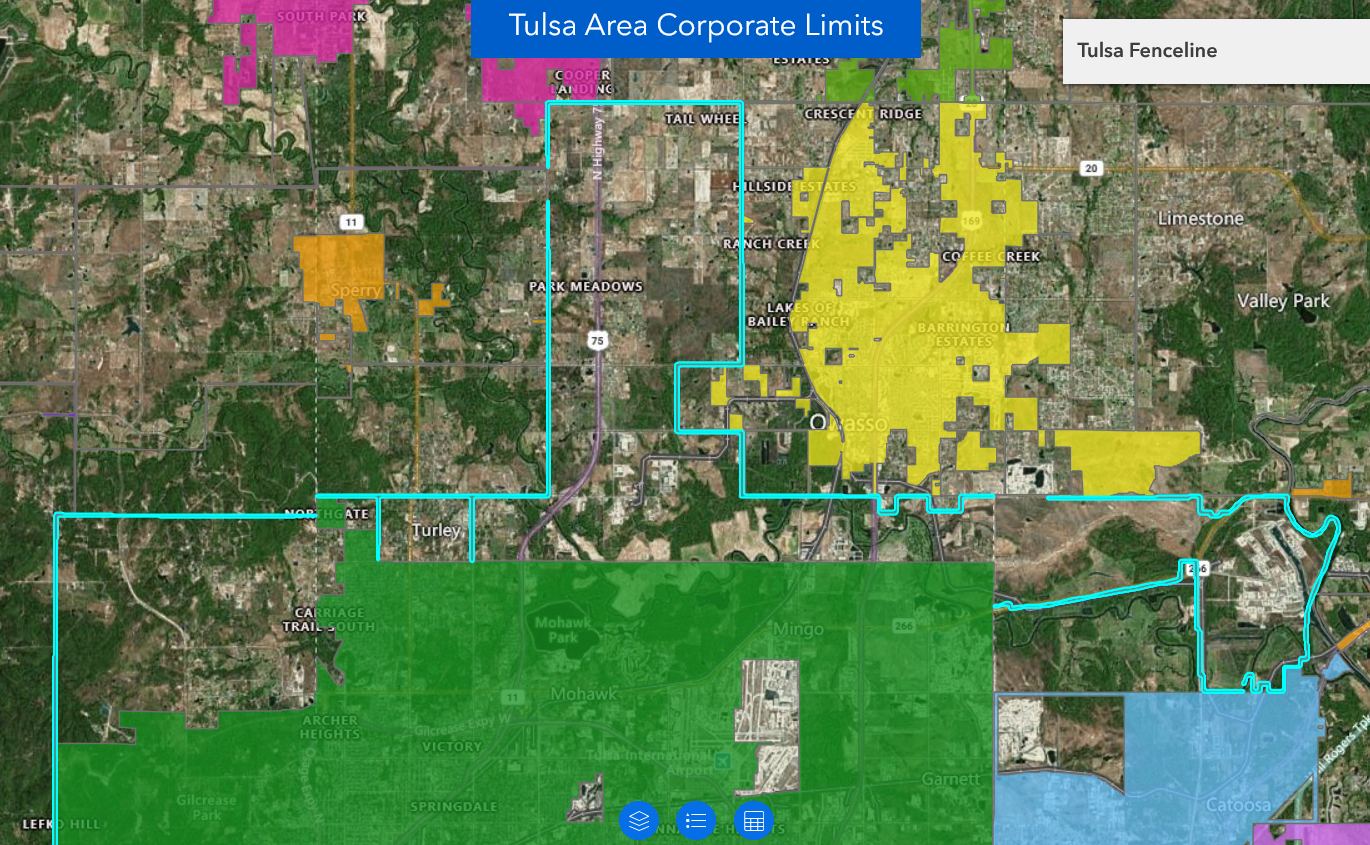 Screenshot from INCOG Tulsa area municipal boundaries interactive map showing Tulsa's northern fence line, outlined in cyan, adopted in 1973 with some adjustments since. The fence line is continuous; the visible discontinuities are an artifact of the map rendering software.
Screenshot from INCOG Tulsa area municipal boundaries interactive map showing Tulsa's northern fence line, outlined in cyan, adopted in 1973 with some adjustments since. The fence line is continuous; the visible discontinuities are an artifact of the map rendering software.When our family moved to the Tulsa area in 1969, we bought a house in Rolling Hills, a geographically confusing place where we had a Tulsa address, paid the City of Tulsa for water, went to Catoosa schools, had a Catoosa phone number, but we were (at that time) in unincorporated Wagoner County. We had no police protection, the sheriff was an hour's drive away, there was a volunteer fire department, and roads were "maintained" by our Wagoner County Commissioner. There were a couple of failed annexation attempts in the 1970s. We moved a mile west into the City of Tulsa in 1978. Rolling Hills was annexed by Catoosa in 1997. (An extended reminiscence about Rolling Hills when it was "No Man's Land" will appear in a separate article.)
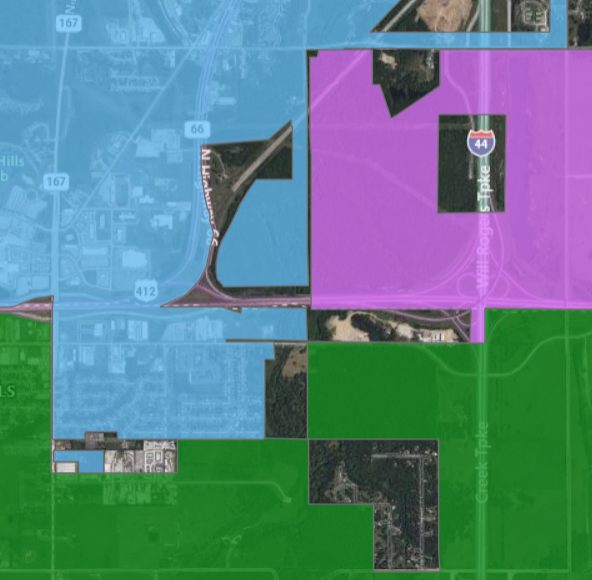 Screenshot from INCOG Tulsa area municipal boundaries interactive map showing the junction of I-44, US 412, and OK 66. Tulsa is green, Catoosa is blue, Fair Oaks is purple. Rolling Hills is the southernmost blue area, surrounded by green to the west, south, and east.
Screenshot from INCOG Tulsa area municipal boundaries interactive map showing the junction of I-44, US 412, and OK 66. Tulsa is green, Catoosa is blue, Fair Oaks is purple. Rolling Hills is the southernmost blue area, surrounded by green to the west, south, and east.All that to say, I appreciate the confusion that people may feel. To address the specific situations my readers raised:
District 1 and Osage County: The City of Tulsa was entirely located in Tulsa County until 1959, when the city annexed several near-downtown subdivisions in Osage County, along with the Tulsa Country Club. A new master-planned community, Gilcrease Hills, opened in 1971. Tulsa annexed a fence-line around the development in 1973, protecting Gilcrease Hills against annexation by Sand Springs, and then annexed the development itself in 1978. Both the incumbent and the challenger for the District 1 Council seat live in Gilcrease Hills. From 1973-1991, Gilcrease Hills had its own K-8 school district, Academy Central. 3,619 City of Tulsa voters live in Osage County, 73% of them Democrats. 1,167 voted in the mayor's race, 794 for Nichols, 291 for Keith, 66 for VanNorman, 16 for other candidates.
Rogers County: Tulsa's 1973 fence line annexation also looped around the Port of Catoosa and 26 square miles, but was reduced in extent in January 1974, to appease Rogers County officials. For the last 50 years, Tulsa has had a 70'-wide fence line that extends into Rogers County along the south side of 66th Street North, around the Port of Catoosa (owned by a joint City of Tulsa and Rogers County authority), then along State Highway 266 back to the Tulsa County line at 145th East Avenue. While the fence line encompasses 10 square miles, no one lives in the 70-foot strip itself, so there are no eligible Tulsa voters in Rogers County. Nevertheless, the Rogers County Election Board opened and staffed the four precincts through which the fence line runs -- 660020, 660021, 660120, 660200 -- even though there were no eligible voters for any elections in those precincts. Thus, the zero vote results in the mayor's race and the District 3 Council race.
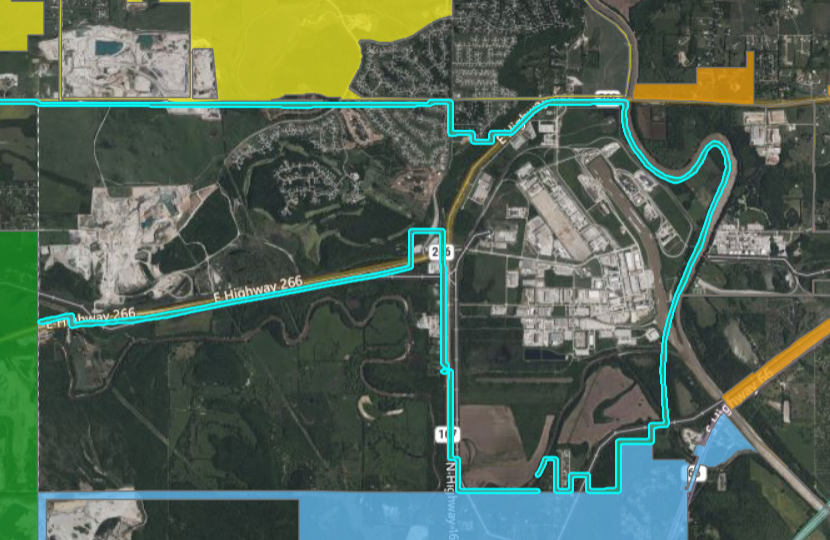 Screenshot from INCOG Tulsa area municipal boundaries interactive map showing Tulsa's fence line (green, outlined in cyan) surrounding the Port of Catoosa. Owasso is yellow, Verdigris is orange, Catoosa is blue. Note that Stone Canyon development is unincorporated but partly within Tulsa's fence line, partly within Owasso's, and partly within neither.
Screenshot from INCOG Tulsa area municipal boundaries interactive map showing Tulsa's fence line (green, outlined in cyan) surrounding the Port of Catoosa. Owasso is yellow, Verdigris is orange, Catoosa is blue. Note that Stone Canyon development is unincorporated but partly within Tulsa's fence line, partly within Owasso's, and partly within neither.News reports from 1973 and 1974 indicate that the fence line was continuous, but modern maps are confusing. The INCOG interactive map shows a continuous fence line, but as a separate object from the rest of Tulsa, which is different from the way other area cities are depicted. The City of Tulsa's interactive council district map shows the Gilcrease Turnpike fence line near Berryhill, but not the northern fence line; ditto for the OU Center for Spatial Analysis data set. The City of Tulsa redistricting commission's proposed district map from 2021 showed the northern fence line, but with a gap along the southern and southwestern sides of the Port property. Google Maps shows the fence line reaching the Port property but stopping there. Rogers County GIS map shows a continuous fence line.
Wagoner County: On November 8, 2001, the City of Tulsa annexed 13 square miles of land in a fourth county, Wagoner County, most of it formerly in the sparsely populated town of Fair Oaks. There are 22 registered voters in the Wagoner County portion of Tulsa; 7 of them voted in the mayoral election -- 4 for VanNorman, 2 for Keith, 1 for Nichols.
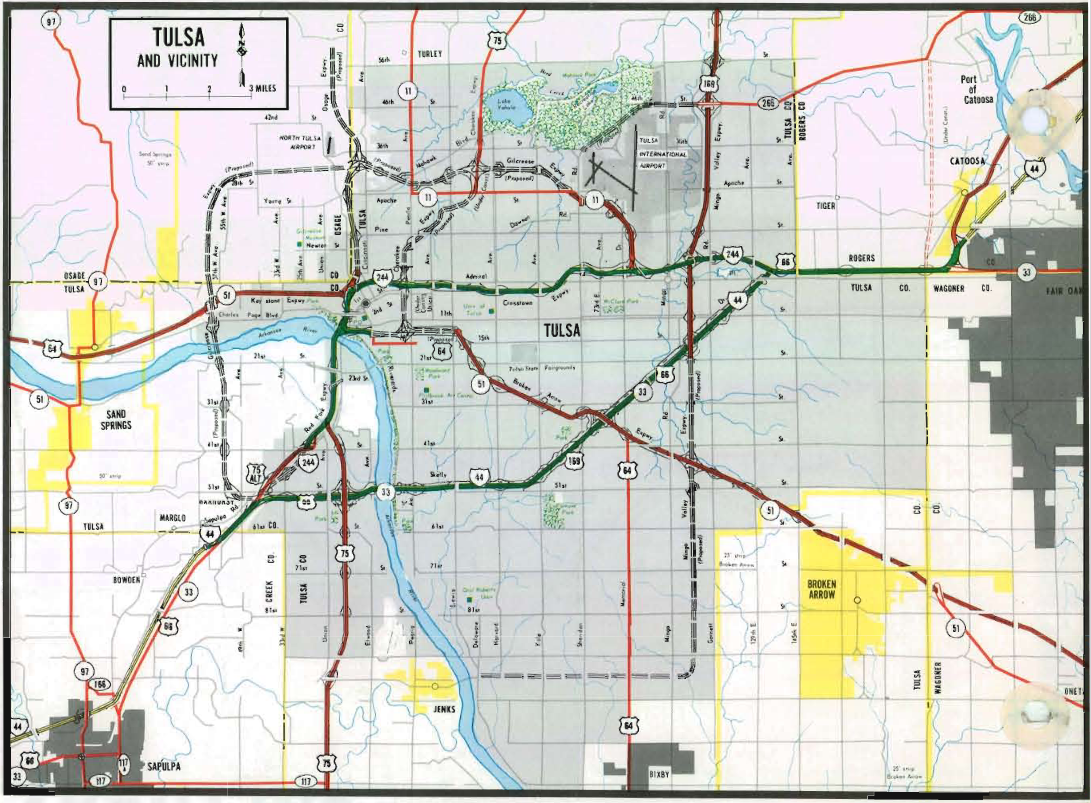 Tulsa metro inset from 1974 Oklahoma state highway map, showing municipal boundaries, including part of Fair Oaks in Wagoner and Rogers Counties. Broken Arrow and Sand Springs fence lines are marked and labeled, but not Tulsa's.
Tulsa metro inset from 1974 Oklahoma state highway map, showing municipal boundaries, including part of Fair Oaks in Wagoner and Rogers Counties. Broken Arrow and Sand Springs fence lines are marked and labeled, but not Tulsa's.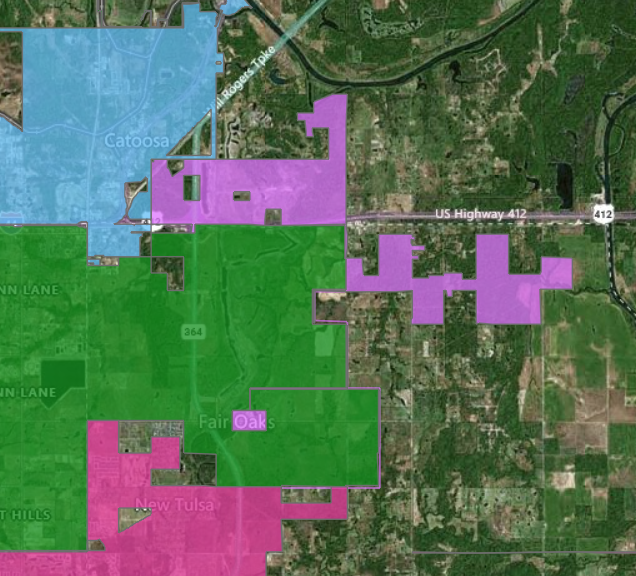 Screenshot from INCOG Tulsa area municipal boundaries interactive map showing Tulsa's Wagoner County area, in green, with the remnant of Fair Oaks in purple.
Screenshot from INCOG Tulsa area municipal boundaries interactive map showing Tulsa's Wagoner County area, in green, with the remnant of Fair Oaks in purple.Turley: A company incorporated in 1906 to develop Turley, and Turley townsite's plat was filed in 1910, but it doesn't appear that the town ever incorporated as a municipality. It was four or five miles away from Tulsa's northern border at the time of its founding. New subdivisions nearby were annexed by Tulsa in the 1950s, and Turley was considered for annexation, but a sanitary sewer bond issue complicated the process. The City of Tulsa would had to have assumed the sewer debt, but would not have been allowed to charge Turley residents more for water and sewer than other Tulsa residents. So despite Tulsa street names and Tulsa water and Tulsa public schools, despite being surrounded by the Tulsa fence line, Turley remains an unincorporated community with the Tulsa County sheriff handling law enforcement, the District 1 County Commissioner responsible for roads, and a volunteer fire department. Turley community is in precincts 720026 and 720326, neither of which has any voters in Tulsa. It's puzzling that the precincts didn't open anyway, because of the fence line, while the similarly situated Rogers County precincts did open.
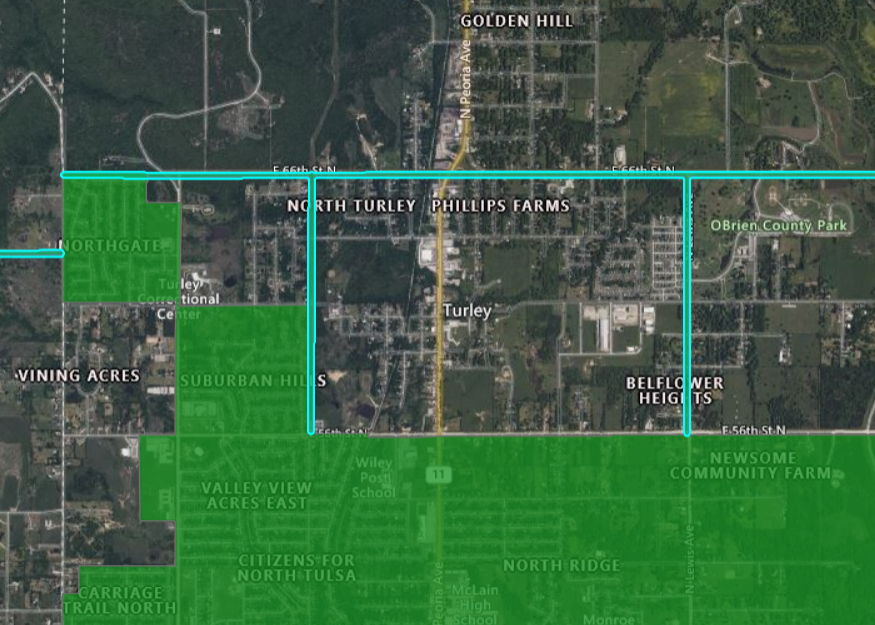 Screenshot from INCOG Tulsa area municipal boundaries interactive map showing Turley, O'Brien Park, and surrounding areas. Note that Suburban Acres and Northgate are within Tulsa's city limits (green), but not Turley or any other neighborhood north of 56th Street North. Tulsa's fence line is green outlined in cyan.
Screenshot from INCOG Tulsa area municipal boundaries interactive map showing Turley, O'Brien Park, and surrounding areas. Note that Suburban Acres and Northgate are within Tulsa's city limits (green), but not Turley or any other neighborhood north of 56th Street North. Tulsa's fence line is green outlined in cyan.A 1977 state law prevents new municipal incorporations within five miles of large cities (over 200,000) or three miles from small cities and towns, but it was amended in 2004, 2006, and 2007 to allow incorporation of territory "that has historically been identified as a community of people residing in compact form." Berryhill may incorporate under these terms, despite being sandwiched between Tulsa and Sand Springs, and it appears that Turley could as well.
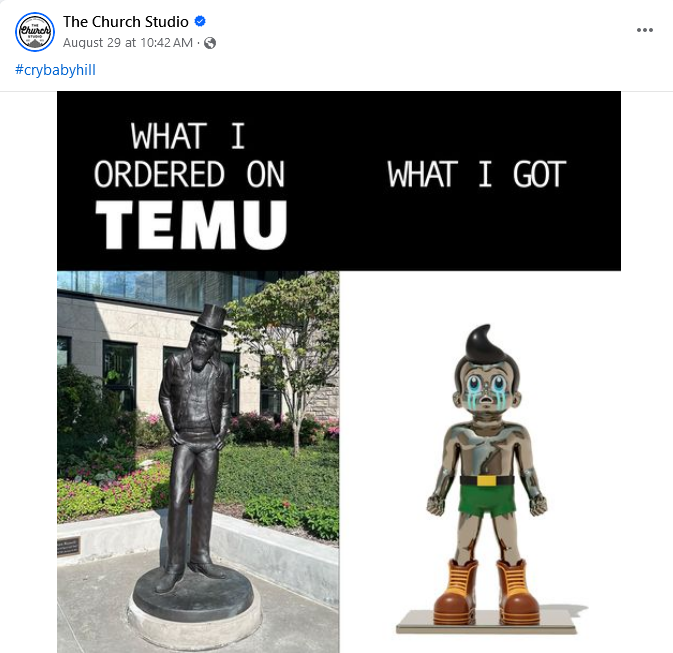 The Church Studio throws some shade at Ken Kelleher's first Cry Baby Hill proposed statue
The Church Studio throws some shade at Ken Kelleher's first Cry Baby Hill proposed statue